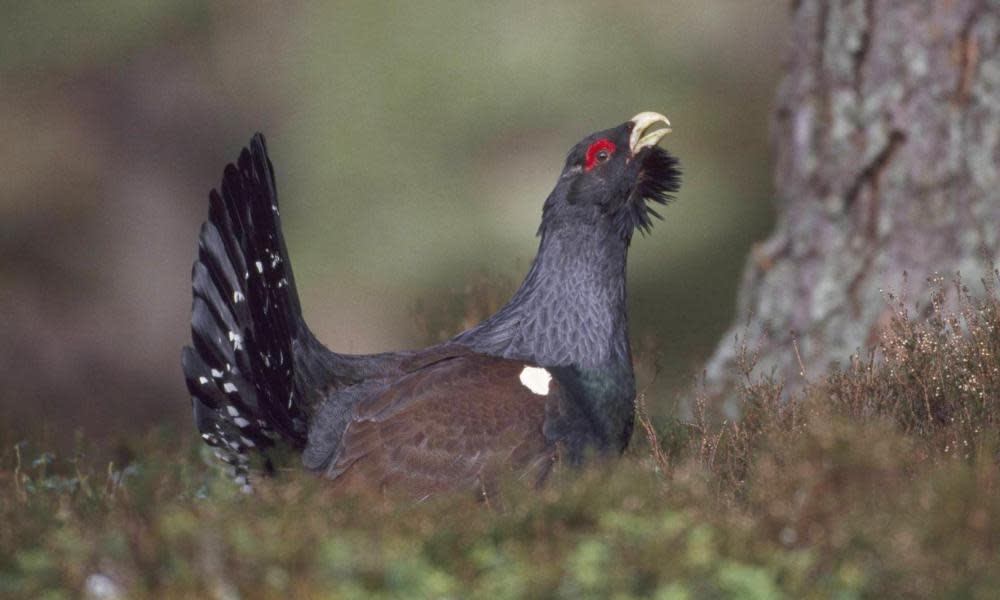Call for action to protect Scotland's endangered capercaillie birds

Conservationists have called for action to protect the capercaillie, one of Scotland’s rarest and most treasured birds, after data showed its population had fallen 50% in just over two decades.
An extensive field survey of capercaillie breeding grounds in the Highlands estimated a population of only 1,114 birds between 2015 and last year, compared with an estimate of 2,200 between 1992 and 1994.
The world’s largest type of grouse, the capercaillie was placed on the UK’s red list of the most endangered birds after a severe population decline from the 1970s onwards.
The survey suggests the shy and elusive bird, which was reintroduced to Scotland in the 1830s after a previous extinction, is now almost wholly restricted to forests in Strathspey in the Cairngorms, where more than 80% of the remaining birds live.
It is believed to have wholly disappeared from the islands where it once lived on Loch Lomond, and its numbers are shrinking fast in Deeside and Perthshire, raising questions about the overall conservation effort to protect it.
Ornithologists blame changing climate (affecting important plants for the capercaillie such as the blaeberry), collision with deer fences, predation and increasing pressure from housing developments and sports such as mountain biking for the decline.
Its breeding has been hit hard by increasingly wet and erratic weather conditions in spring and early summer depleting food supplies when capercaillie hens are readying to breed, and during the first week of a chick’s life.
After previous surveys recorded a sudden slump in capercaillie numbers in the late 1990s, where the population fell to 1,073, conservationists removed or made more visible hundreds of miles of deer fences in long stretches of the Highlands, to prevent adult birds flying into them. Yet the latest figures show a continuing Scotland-wide decline in overall numbers.
The field surveys, overseen by the government agency Scottish Natural Heritage and carried out over the winter every six years, show there were an estimated 1,980 capercaillie in 2003-2004, 1,285 in 2009-2010 and 1,114 in the latest survey.
Conservationists warn that the pressures of climate change on the species is being exacerbated in the Cairngorms national park, now its last stronghold, by large scale house-building projects and recreational pressures being permitted or overseen by the park authority.
The national park is being heavily marketed for outdoor sports, where mountain biking paths, hill walking and countryside sports can disturb the bird throughout the year and increase the fragmentation of its breeding and feeding areas.
Gus Jones, an expert in capercaillie ecology with the Badenoch and Strathspey Conservation Group, said: “Inappropriate large-scale housing needs to be restricted because we have pretty limited woodland. Housing and recreational pressures in the wrong places are sterilising large areas which capercaillie need or are making them less suitable.”
SNH confirmed that its efforts to protect the bird were now focusing on the Cairngorms. It said work was going on to help capercaillie outside the park area but did not identify new projects designed to do so.
“The latest national survey shows that the majority of capercaillie in Scotland are within the Cairngorms national park so it is appropriate to focus our limited resources there,” a spokesman said. “However, action will still continue outwith the park’s boundaries.”
Cairngorms national park said its capercaillie strategy was intended to heavily involve the local community and carefully manage recreational activities to protect its habitats. “We hope to develop a programme of conservation action to support the long-term survival of the species and provide a model to save ‘at risk’ species in national parks around the world,” said Andy Ford, the park’s nature manager.

 Yahoo News
Yahoo News 
